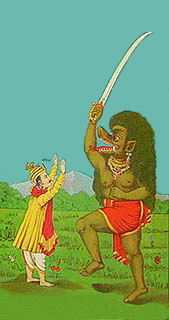Kali Yuga
![]()
This article or section needs revision. More details should be given on the discussion page. Please help improve it, and then remove this tag.
Kaliyuga (Sanskrit, n., कलियुग, kaliyuga literally "age of Kali", "age of strife") is the name for the last of four ages, the Yugas in Hindu cosmology. It is considered the age of decay and ruin. As such, it has often been related to the Greek Iron Age described by Hesiod in the Theogony and also called the "Iron Age". The others are Satya Yuga (or Krita Yuga), Treta Yuga and Dvapara Yuga.
Lord of this time is the black apocalyptic demon Kali, according to Vishnu Purana the negative manifestation of Vishnu, who in this form is responsible for the destruction of the universe. Kaliyuga is also (incorrectly) often associated with the goddess Kali (kālī), who generally represents dark, material aspects. Kali also denotes the losing side of the dice, denoted by a dot.
According to Buddhist cosmology, such a dark age refers to the fourth and last major period of time of a period of approximately 3,000 years, after the birth of a Buddha until the appearance of a new Buddha.
The Hindu and Buddhist terms for Kaliyuga refer in principle to the same thing - a final age of four. What differs, however, is the length given in each case, which in Hinduism can reach a range of between 1,200 and 360,000 "human years". It is often unclear whether "human years" or the much longer lasting "gods' years" are meant. Among other scriptures, the Vishnu Purana and the Manusmrti deal with this topic.

Demon of Kali-Yuga
Age of Decline
According to tradition, after the appearance of a teaching Buddha, the age gradually degenerates. After an age called golden, silver, and copper, we are now in the so-called "iron age," in which the outer world as well as the spiritual condition of beings are very much affected by the three root poisons of hatred, greed, and confusion. The "black age" is therefore affected by war and widespread suffering to a greater extent than the preceding ages were. It is also called the "Age of Decline." In such an age, only a few beings still have the ability to practice meditation for spiritual development and require very powerful methods to lead the mind to full enlightenment.
End of the Kali Yuga
What follows after the end of the Kali Yuga is controversial. In Hindu lore, several possibilities are open: 1.) A new Golden Age (Satya Yuga) appears immediately, instantly replacing disorder and suffering with "divine" order and knowledge. 2.) A slow ascent through a new Dvapara and Treta Yuga to a new Satya Yuga occurs analogous to the preceding descent.
In Buddhism as well as in Jainism, the last and dark age generally takes on an eschatological hue and is adapted to the teachings of salvation and redemption. At the end of a black age, according to Buddhist tradition, a new Buddha appears who once again proclaims enlightened teachings, whereupon a new age of truth (satya yuga) dawns. In an age of truth, beings find easy access to spiritual practice, and the minds of beings are little veiled by mind poisons. In this aeon (Sanskrit kalpa), according to legend, 1,000 Buddhas will appear, setting the "wheel of teaching" in motion once again. According to Buddhist tradition, Buddha Shakyamuni (563 B.C.) was the fourth Buddha to appear in this aeon. The appearance of the fifth Buddha named Maitreya is predicted for a few centuries. The last of 1,000 Buddhas of this eon will bear the name Möpa (Tibetan for "completion") at the end of an inconceivably long period of time. Thus, according to tradition, the auspicious time cycle of this aeon will close, and the world as we know it will be annihilated.
Questions and Answers
Q: What is Kali Yuga?
A: Kali Yuga is one of the four stages, or yugas, that the world goes through in Hinduism. It is considered the "Age of Kali" or "age of vice".
Q: How long is Kali Yuga believed to be in Hinduism?
A: Most Hindus believe that Kali Yuga is 432,000 years long.
Q: Is Kali Yuga recognized in Sikhism?
A: Yes, Kali Yuga is recognized and stated in Sikhism in the Guru Granth Sahib.
Q: What does the term "Kali" mean in Kali Yuga?
A: "Kali" in Kali Yuga translates to "vice" or refers to the degenerate state of humanity during this stage.
Q: How does Kali Yuga differ from the other yugas in Hinduism?
A: Kali Yuga is considered the most degenerate and corrupt of the four yugas, while the other three are considered progressively better.
Q: What are the other three yugas in Hinduism?
A: The other three yugas in Hinduism are Satya Yuga, Treta Yuga, and Dvapara Yuga.
Q: What is the significance of understanding Kali Yuga in Hinduism and Sikhism?
A: Understanding and recognizing Kali Yuga allows for a deeper understanding of the cyclical nature of existence and the need for spiritual growth and an ethical way of life, as well as the recognition of societal flaws that may arise during this age.
Search within the encyclopedia